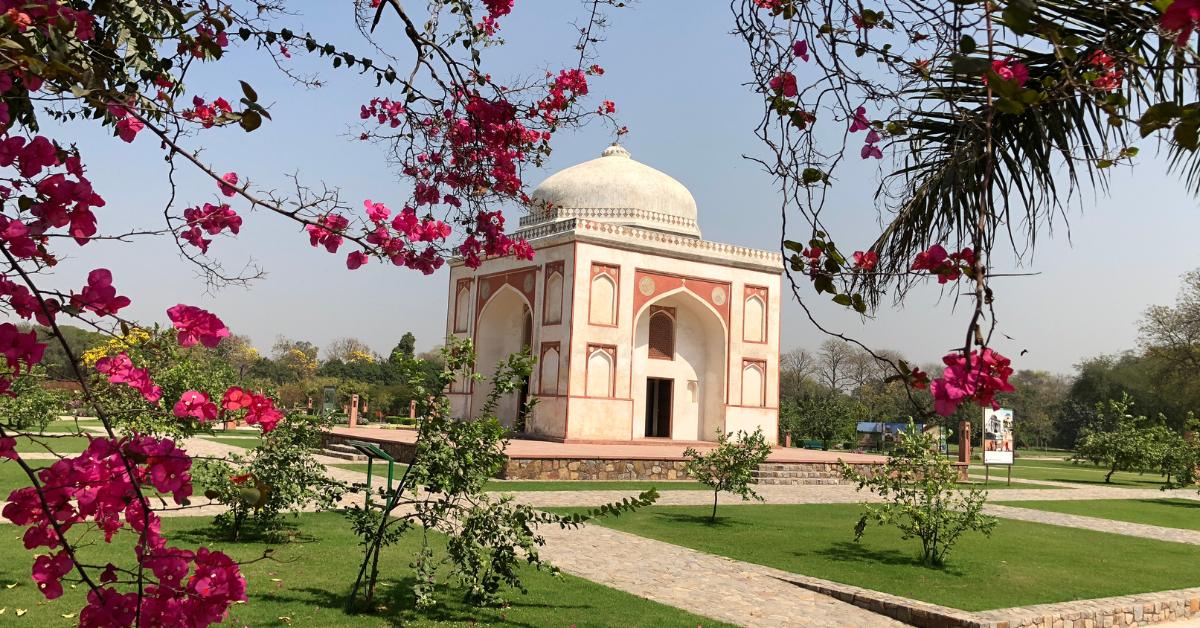Welcome to Trip Trek Tales, your travel and tourism guide that helps you in planning your trips. Today we are going to explore one of the hidden gem of Delhi, it is a monument and a beautiful park as well. We are talking about Sunder Nursery, situated close to the Humayun Tomb.
Sunder Nursery is a peaceful and charming city park and a heritage site that offers a blend of history, culture, and nature. This hidden beauty often remains hidden due to other trending and popular locations and monumental sites of Delhi, like Red Fort, Qutub Minar, etc. But to be honest, this is an ideal city park made for both tourists and those who want to spend a good time with their loved ones. It has peace, tranquillity, and nature. So, let’s talk about Sunder Nursery in detail today in this blog. We will suggest you to read till the end as we will share some important things about this park that will surely help you to plan your day trip to this place.
The Historical Legacy of Sunder Nursery
Dating back to the Mughal era, Sunder Nursery was originally established in the 16th century as a royal garden and burial ground. The name “Sunder” comes from the Sanskrit word sundara, meaning beautiful—a fitting description of this verdant space. The nursery was later utilized by the British as a hub for plant experimentation. However, over the years, it fell into neglect.
In the year 2007, there was graceful phase change. The Aga Khan Trust for Culture (AKTC) along with Archaeological Survey of India (ASI) and other agencies launched a large scale restoration program. The outcome was a 90 acre heritage park that interweaves Mughal Architecture, Gardens and Biodiversity. Finished in 2018, Sunder Nursery is now part of a UNESCO World Heritage Site. The landscape is along with other UNESCO structures like Humayun’s Tomb and Nizamuddin Basti.
Monuments to Marvel At
Within Sunder Nursery, there are 15 Mughal monuments where some were built over 500 years ago. Each of these monuments has its own narrative that adds to the Delhi’s colorful architectural history. Here are some of the places you absolutely can’t skip:
- Sunder Burj: This 16th-century octagonal tomb, adorned with intricate tile work and plaster designs, is one of the earliest examples of Mughal garden tombs.
- Sunderwala Mahal: Built for an unknown noble, this tomb later served as a British residence. Its elegant arches and dome reflect simplicity and grace.
- Lakkarwala Burj: A hexagonal tomb built for a timber merchant, known for its distinctive conical dome and stone carvings.
- Mirza Muzaffar Hussain’s Tomb: A stunning 17th-century structure with floral motifs and calligraphy, built for a nobleman related to Emperor Aurangzeb.
Each monument is beautifully integrated into the park’s landscape, making Sunder Nursery a paradise for history buffs and photographers alike.
Gardens That Captivate
Sunder Nursery has a great cultural value but also a natural twist. The site bears with it 20 artfully conceived gardens whose floral and landscape styles are diverse.
- Heritage Garden: Designed in the Mughal charbagh style, this garden boasts symmetrical layouts, water channels, and fountains that evoke a sense of timeless elegance.
- Bonsai Garden: Home to over 80 varieties of bonsai plants, some more than a century old, this garden is a treat for plant enthusiasts.
- Lotus Garden: Celebrating India’s national flower, the Lotus Garden enchants visitors with vibrant blossoms and a lotus-shaped fountain.
- Rose Garden: A fragrant collection of over 30 rose varieties, enhanced by a picturesque gazebo and pergola.
- Herb Garden: Featuring over 50 types of medicinal and aromatic herbs, this garden educates visitors about traditional healing practices.
Biodiversity at Its Best
If you think Sunder Nursery is just a heritage park, then it is time to rethink. It is also a biodiversity hotspot. This charming city park is home to more than 300 species of flora and fauna. Those who love birdwatching and wildlife can come to this place to enjoy the vibrant ecosystem of Sunder Nursery.
- 80+ bird species like the Indian Pitta and Indian Paradise Flycatcher.
- 36 butterfly species, including the striking Red Pierrot and Common Leopard.
- Reptiles such as the Indian Rock Python and amphibians like the Indian Flapshell Turtle.
The park also features dedicated microhabitats, such as wetlands, grasslands, and orchards, ensuring a thriving environment for its diverse inhabitants.
Cultural and Recreational Activities
Sunder Nursery offers more than just sightseeing. It’s a cultural hub with activities for all age groups.
- Concerts and Festivals: From soulful Sufi performances to vibrant festivals celebrating biodiversity, there’s always something happening at the park’s amphitheatre or open lawns.
- Workshops and Exhibitions: Learn pottery, calligraphy, or gardening through engaging workshops, or visit exhibitions showcasing the park’s history and biodiversity.
- Picnics and Leisure: Designated picnic spots with tables and umbrellas make for a delightful outing with family and friends.
Planning Your Visit to Sunder Nursery
To make the most of your visit, here are some practical details and tips.
1. Sunder Nursery Timings
The park is open from 7:00 AM to 7:00 PM, every day except Mondays. Plan your visit during early mornings or late afternoons for pleasant weather and stunning natural light.
2. Sunder Nursery Ticket Price
- Entry fee for Indians: ₹50
- Entry fee for foreigners: ₹200
- Car parking fee: ₹100 (on weekdays for 4 hours), 200 (On weekends for 4 hours)
- Two wheelers parking fee: ₹35 for 4 hours
- Annual pass: There is also an annual pass that you can have, visit the official website to check the price.
Tickets can be purchased online or at the park entrance.
3. Sunder Nursery Location and Access
Sunder Nursery is located near Humayun’s Tomb and Nizamuddin Railway Station. The exact address of this park is: Bharat Scouts and Guides Marg, Opposite Humayun’s Tomb, Nizamuddin, National Zoological Park, Sundar Nagar, New Delhi, Delhi 110013.
4. Sunder Nursery Nearest Metro Station
JLN Stadium and Jor Bagh stations are the closest. From there, take an auto-rickshaw or a cycle-rickshaw to the park. If you are thinking of travelling to this place by metro, then these two stations are the most suitable for you.
Alternatively, you can take a bus to Nizamuddin Bus Stand or drive directly to the park. Limited parking is available.
What to Bring While Visiting Sunder Nursery
- Essentials: Carry water, snacks, sunscreen, a hat, and sunglasses. However, note that plastic bottles and bags are prohibited inside the park.
- Camera or Smartphone: Don’t miss capturing the mesmerising Sunder Nursery photos, especially during golden hour.
- Binoculars: Perfect for birdwatching and spotting butterflies in their natural habitats.
Tips for a Memorable Experience At Sunder Nursery
- Wear Comfortable Clothes: Opt for lightweight, modest attire and sturdy footwear to explore the park’s vast expanse.
- Avoid Weekends: The park tends to get crowded on weekends and public holidays. Visiting on a weekday ensures a more peaceful experience.
- Join Guided Tours: Enrich your visit by joining a guided tour to learn fascinating insights about the park’s history and ecology.
- Pack a Picnic: Enjoy a relaxing meal in the designated picnic areas, but ensure you clean up after yourself.
Read Also: Waste To Wonder Theme Park, Delhi
Why You Should Visit Sunder Nursery
Sunder Nursery is a rare blend of Delhi’s vibrant past and lush greenery. It offers an unparalleled opportunity to step away from the city’s chaos and immerse yourself in history and nature. The thoughtfully restored monuments, exquisite gardens, and diverse wildlife make it a destination that caters to everyone.
Whether you’re a solo traveler, a family, or a group of friends, a visit to Sunder Nursery is sure to leave you inspired. So, plan your trip, soak in the serenity, and capture unforgettable memories.
Sunder Nursery Photos, majestic monuments, and tranquil gardens await your exploration – don’t miss this extraordinary destination in the heart of Delhi!

